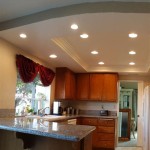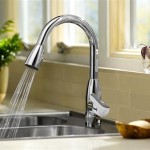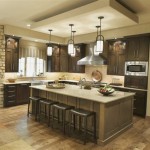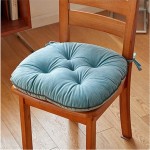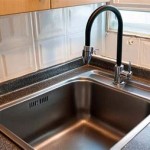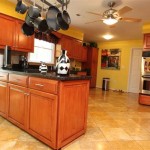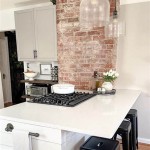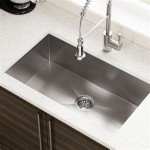Kitchen Floor Ideas That Complement Oak Cabinets
Oak cabinets possess a timeless appeal, offering warmth and character to any kitchen design. However, selecting the right flooring to pair with oak cabinets can be a challenging endeavor. The flooring choice profoundly impacts the overall aesthetic and functionality of the kitchen. This article provides a comprehensive exploration of various flooring options that harmonize with oak cabinets, considering factors such as color palettes, material properties, and design styles.
The inherent characteristics of oak wood, including its grain pattern and warm undertones, must be considered when selecting a complementary floor. Understanding these characteristics is paramount to creating a cohesive and visually appealing kitchen design. The overarching goal is to strike a balance between the visual weight of the cabinets and the flooring, ensuring that neither overpowers the other.
Understanding the Undertones of Oak Cabinets
Oak wood typically exhibits warm undertones, ranging from yellow and orange to reddish hues. The specific undertones can vary depending on the species of oak and the finish applied to the cabinets. Identifying these undertones is crucial for selecting flooring that complements the cabinets' existing color palette. For instance, if the oak cabinets have a strong yellow undertone, consider floors with cooler tones, such as gray or blue, to create a harmonious contrast. Conversely, if the cabinets have reddish undertones, warmer flooring options, like terracotta or deep browns, may be more suitable.
Furthermore, the grain pattern of the oak cabinets contributes significantly to their visual texture. Flooring with a simple, understated design can help to balance the visual complexity of the cabinets. Conversely, if the cabinets have a subtle grain pattern, a more textured flooring option can add visual interest to the space. Consideration must be given to the overall flow of the kitchen and how the flooring contributes to the spatial perception. A lighter floor can visually expand a smaller kitchen, while a darker floor can ground a larger kitchen and create a sense of intimacy.
Exploring Popular Flooring Options
A wide array of flooring options exists, each with its own unique advantages and disadvantages when paired with oak cabinets. Several popular options are detailed below, considering their aesthetic compatibility, durability, and maintenance requirements.
Hardwood Flooring: Hardwood flooring is a classic choice that complements oak cabinets beautifully. Opting for hardwood in a contrasting tone, such as a dark walnut or a light maple, can create a visually striking effect. The natural warmth of hardwood flooring harmonizes with the warmth of oak, resulting in a cohesive and inviting space. Hardwood offers durability and longevity, but it requires regular maintenance, including refinishing, to preserve its appearance. Scratches and dents are possible, particularly in high-traffic areas.
Tile Flooring: Tile flooring, including ceramic and porcelain, provides a versatile and durable option for kitchens. Tile is resistant to water damage, making it an ideal choice for kitchens where spills are common. When choosing tile for a kitchen with oak cabinets, consider selecting a tile with a neutral color palette, such as gray, beige, or off-white. These colors provide a subtle backdrop that allows the oak cabinets to stand out. Consider the tile size, as larger tiles can make a small kitchen appear more spacious. Grout color is also a vital consideration; a contrasting grout color can add visual interest, while a matching grout color creates a seamless look.
Laminate Flooring: Laminate flooring offers a cost-effective alternative to hardwood, mimicking the appearance of wood or tile at a fraction of the price. Laminate is relatively easy to install and maintain, making it a popular choice for budget-conscious homeowners. When selecting laminate flooring for a kitchen with oak cabinets, consider opting for a design that complements the cabinets' color and grain pattern. Laminate is less resistant to water damage than tile, so it is essential to clean up spills promptly. High-quality laminate options offer increased durability and water resistance.
Vinyl Flooring: Vinyl flooring, available in sheet, tile, and plank formats, offers a durable and waterproof flooring option. Vinyl is comfortable underfoot and relatively easy to clean, making it well-suited for kitchens. Luxury vinyl plank (LVP) and luxury vinyl tile (LVT) are particularly popular choices, as they offer realistic wood or tile textures and patterns. When pairing vinyl flooring with oak cabinets, consider selecting a design that complements the cabinets' color and style. A light-colored vinyl floor can brighten up a kitchen with dark oak cabinets, while a darker vinyl floor can create a more grounded and traditional look.
Engineered Wood Flooring: Engineered wood flooring offers a balance between the aesthetic appeal of hardwood and the durability of other flooring options. Engineered wood consists of a thin layer of hardwood veneer bonded to a core of plywood or other composite material. This construction makes engineered wood more resistant to moisture and temperature fluctuations than solid hardwood. When choosing engineered wood flooring for a kitchen with oak cabinets, consider selecting a species and finish that complements the cabinets' color and grain pattern. Engineered wood can be refinished, extending its lifespan and allowing homeowners to refresh its appearance.
Color Coordination and Design Styles
The color palette of the flooring should complement the color of the oak cabinets and contribute to the overall design style of the kitchen. Certain color combinations work better than others, depending on the desired aesthetic. Furthermore, the design style of the kitchen – whether it be traditional, modern, farmhouse, or transitional – will influence the choice of flooring.
Traditional Kitchens: In traditional kitchens, warmer flooring options, such as hardwood with a medium stain or terracotta tile, can create a cohesive and inviting atmosphere. Consider flooring with intricate patterns or textures to enhance the traditional aesthetic. Avoid overly modern or minimalist flooring designs, as they may clash with the traditional cabinetry. The choice of area rugs can further enhance the warmth and character of the space.
Modern Kitchens: In modern kitchens, cooler flooring options, such as gray tile or concrete, can provide a striking contrast to the warmth of oak cabinets. Opting for flooring with clean lines and a minimalist design can complement the sleek aesthetic of modern kitchens. Consider using large-format tiles to create a seamless and contemporary look. Metallic accents, such as stainless steel appliances and hardware, can further enhance the modern style.
Farmhouse Kitchens: Farmhouse kitchens emphasize natural materials and a rustic aesthetic. Flooring options such as reclaimed wood or distressed tile can create a charming and inviting farmhouse look. Colors such as warm grays, creams and beiges work well. Consider adding an area rug with a farmhouse pattern to enhance the style. Shiplap walls and apron-front sinks are commonly incorporated into farmhouse kitchen designs.
Transitional Kitchens: Transitional kitchens blend elements of traditional and modern design, creating a balanced and versatile aesthetic. Flooring options such as engineered wood or tile with a subtle texture can work well in transitional kitchens. Neutral colors, such as beige or gray, provide a versatile backdrop that complements both traditional and modern elements. Carefully selected accessories and lighting fixtures can tie the design together.
Beyond color coordination, considering the texture and reflectivity of the flooring is important. A matte finish can create a more casual and understated look, while a glossy finish can add a touch of elegance and sophistication. The amount of natural light in the kitchen should also be taken into account. Darker flooring can absorb light, making a small or dimly lit kitchen appear even smaller. Lighter flooring can reflect light, making a kitchen feel brighter and more spacious.
Ultimately, the optimal flooring choice for a kitchen with oak cabinets hinges on a comprehensive evaluation of personal preferences, budget constraints, and the desired aesthetic. By meticulously assessing the undertones of the cabinets, exploring various flooring options, and considering the overall design style of the kitchen, homeowners can make informed decisions that yield a cohesive and visually pleasing space.

What New Flooring Goes With 1990s Oak Cabinets Carla Bast Design

Kitchen Tile Floor Ideas With Light Wood Cabinets

Tile Floor Honey Oak Cabinets Google Search For The Home Kitchen Flooring

45 Fantastic Kitchen Floor Ideas And Designs Renoguide N Renovation Inspiration

What To Do With Oak Cabinets Designed

Tips And Ideas How To Update Oak Or Wood Cabinets Paint Stain More

Budget Friendly Kitchen Floor Ideas To Transform Your Space Beautiful Homes

Custom White Oak Hardwood Floors Contemporary Kitchen Los Angeles By Gaetano Inc Houzz

40 Kitchens With Extensive Dark Wood Throughout

3 Kitchen Cabinet Ideas That Go With Oak Flooring

